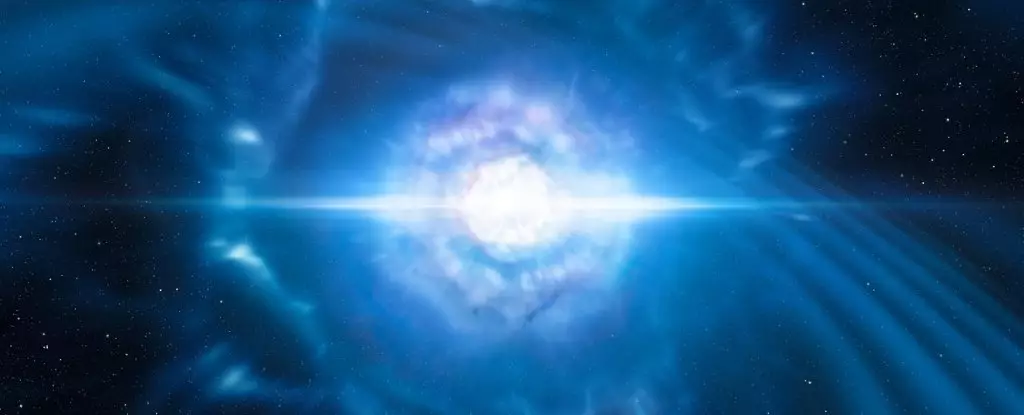In August 2017, a groundbreaking astronomical event unfolded, capturing the attention and imagination of scientists and enthusiasts alike. The collision of two neutron stars, known as a kilonova explosion designated AT2017gfo, was not merely a spectacular show but a significant scientific milestone. The event resonated through the universe, sending ripples in the fabric of spacetime that were detected by gravitational wave observatories, while telescopes across the globe turned their gaze towards the sky, providing a unique opportunity to analyze and collect vast amounts of data.
This unprecedented event laid the groundwork for an exhaustive study that scientists anticipated would yield insights for years to come. The research team led by astrophysicist Albert Sneppen at the Niels Bohr Institute in Copenhagen has now meticulously reconstructed the early hours and days following the kilonova, presenting a detailed narrative of its evolution. What sets this analysis apart is not only the sheer scale and variety of data gathered from multiple observatories but also the innovative ways in which that data was combined. As Sneppen aptly points out, no single telescope could capture the entire story due to the Earth’s rotation, yet by collaborating across international borders, researchers created a comprehensive view of this cosmic phenomenon.
One of the most captivating aspects of the AT2017gfo explosion is its role in the synthesis of heavy elements. Traditionally, the scientific community has understood that elements heavier than iron cannot be produced through the core fusion processes in stars. The energy required to fuse these heavier elements surpasses that which is generated during star formation. Consequently, events like supernovae have been deemed essential for the creation of heavier elements. However, AT2017gfo has unveiled that neutron star mergers are equally adept at forging these cosmic materials, acting as formidable factories in the universe.
The observations collected from the kilonova revealed the presence of strontium and yttrium in the luminous debris of the explosion. This finding was not just a serendipitous discovery; it corroborated long-held theories about the origins of heavy elements. By examining the astronomical light emitted post-explosion, researchers gained the ability to assess elemental synthesis in real-time. This dynamic analysis, broken down hour by hour, allowed for a glimpse into the early formation processes of heavy elements, known as r-process elements, further establishing the significance of kilonovae in the cosmic recycling of matter.
If we revisit the conditions of the early universe, we find ourselves staring into a primordial hot soup of particles, much like the state observed in the aftermath of a kilonova. The temperatures recorded during the initial moments of AT2017gfo reached billions of degrees, reminiscent of the conditions present in the early universe. In this extreme environment, elementary particles darted about, unbound and free-ranging, akin to what occurred shortly after the Big Bang.
As the explosion cooled, these energetic particles began to coalesce, forming atoms—a process strikingly similar to what is theorized to have occurred during the Epoch of Recombination, approximately 380,000 years after the Big Bang. At this critical juncture, the universe transitioned from a hot, opaque state to one in which light could travel freely, forever transforming its landscape. By observing the way atoms formed during the kilonova explosion, researchers suggest that these cosmic events act as miniature laboratories for understanding the behavior and evolution of the early universe.
The analysis conducted by Sneppen and his colleagues offers an unprecedented window into the processes at play within the kilonova. By tracking the evolutionary trajectory of the explosion, they confirmed the coalescence of atomic nuclei and electrons, effectively documenting the birth of new atoms in a distant cosmic event. This understanding mixes elements of theoretical physics with experimental observation, enriching our grasp of cosmic origins.
The research team emphasized the ability to measure temperature and explore the micro-physics involved in these explosive phenomena. This level of detailed comprehension brings humanity one step closer to answering fundamental questions about the nature of our universe and the formation of matter. It’s as if we are peeling back layers of cosmic history, revealing moments of creation that have been hidden from sight—insights that illuminate not just our past but our very existence in this vast expanse.
The astonishing findings from the kilonova AT2017gfo signify a pivotal evolution in our comprehension of heavy element formation and cosmic processes. As we continue to investigate these celestial phenomena, each discovery acts as a stepping stone toward unraveling the mysteries of the universe, reminding us of the intricate connections that define our place within it.

